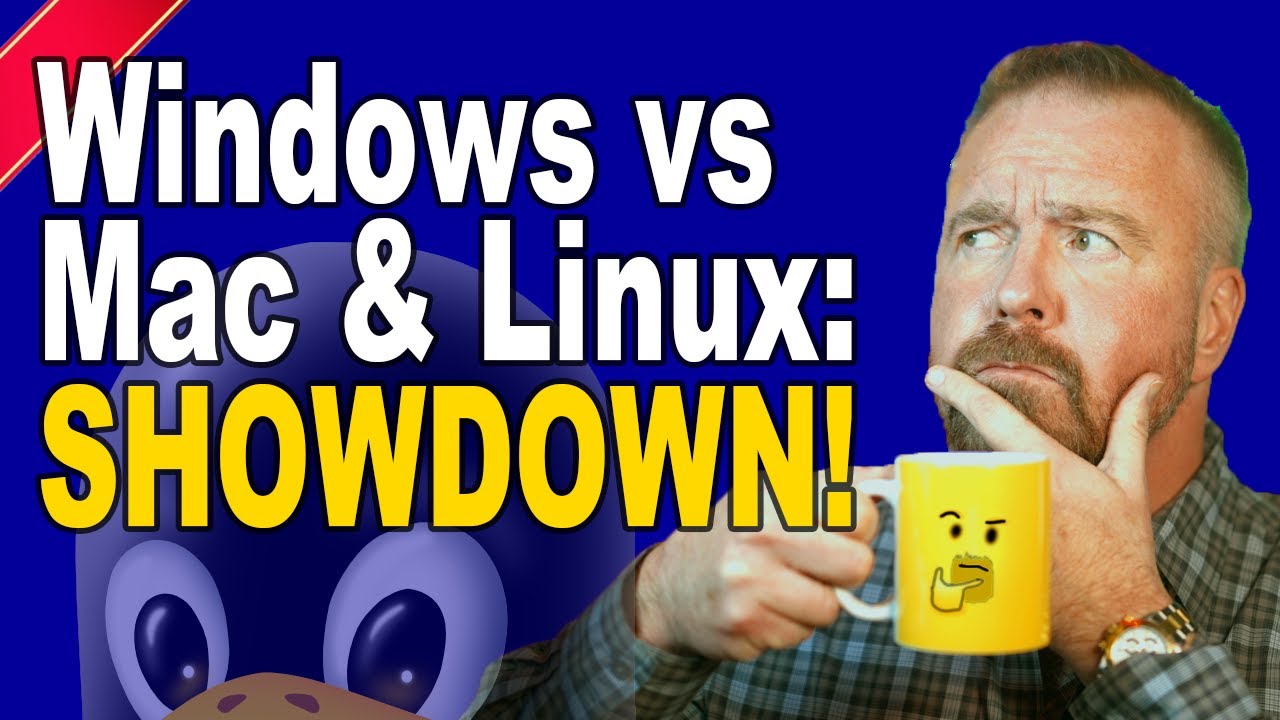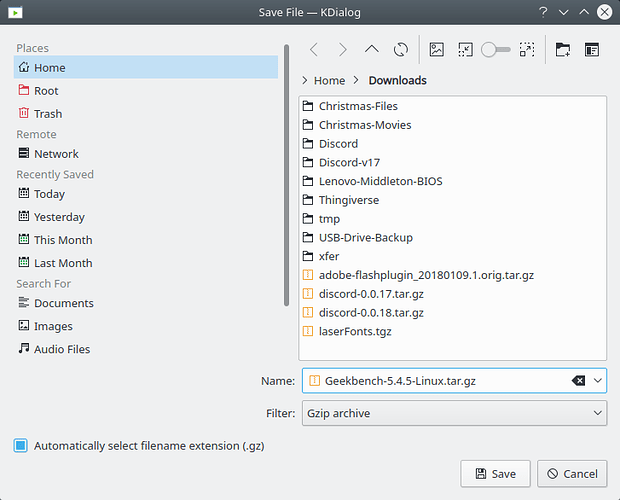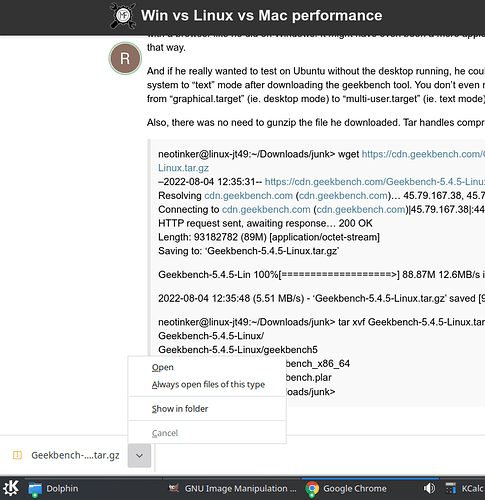“Linux” winning the showdown was pretty much a guarantee since you can customize “Linux” to an extent that is not possible with Windows or Macs but I do have a few pet peeves which usually pop up when non linux users talk about linux.
- There are many Linux distributions and they are not all the same.
He was testing the performance of Ubuntu Linux 20.04, not “Linux”. This is an important distinction because there are many Linux distributions. Some are meant to be generic and others are built for specific purposes. Some like Gentoo are custom compiled for the hardware you install them on and can make use of features specific to that hardware like expanded cpu instruction sets. Most distros compile to a reduced instruction set to be more compatible to a wider range of hardware.
There can also be some variation in supportability due to different relationships between companies. For instance, Ubuntu was the first Linux distro supported on WSL and its performance on WSL would probably be better than others due to tweaks made to Ubuntu and WSL to make it run better.
- Don’t make Linux sound more complicated than it is.
I feel like some people, due to their own inexperience with “Linux”, over complicate things or behave or speak in such a way that their discomfort is visible and it makes Linux seem harder than it is.
The part where he talked downloading geekbench, for instance was fairly cringe-worthy. He didn’t really need to call out the browser/wget related stuff the way he did. There is wget for windows if he wanted to do it the same way on both OSs or he could have just installed a Desktop on Linux and downloaded it with a browser like he did on Windows. It might have even been a more apples to apples comparison that way.
And if he really wanted to test on Ubuntu without the desktop running, he could have switched the system to “text” mode after downloading the geekbench tool. You don’t even need to reboot to switch from “graphical.target” (ie. desktop mode) to “multi-user.target” (ie. text mode).
Also, there was no need to gunzip the file he downloaded. Tar handles compression automatically.
neotinker@linux-jt49:~/Downloads/junk> wget https://cdn.geekbench.com/Geekbench-5.4.5-Linux.tar.gz
–2022-08-04 12:35:31-- https://cdn.geekbench.com/Geekbench-5.4.5-Linux.tar.gz
Resolving cdn.geekbench.com (cdn.geekbench.com)… 45.79.167.38, 45.79.187.69
Connecting to cdn.geekbench.com (cdn.geekbench.com)|45.79.167.38|:443… connected.
HTTP request sent, awaiting response… 200 OK
Length: 93182782 (89M) [application/octet-stream]
Saving to: ‘Geekbench-5.4.5-Linux.tar.gz’Geekbench-5.4.5-Lin 100%[===================>] 88.87M 12.6MB/s in 16s
2022-08-04 12:35:48 (5.51 MB/s) - ‘Geekbench-5.4.5-Linux.tar.gz’ saved [93182782/93182782]
neotinker@linux-jt49:~/Downloads/junk> tar xvf Geekbench-5.4.5-Linux.tar.gz
Geekbench-5.4.5-Linux/
Geekbench-5.4.5-Linux/geekbench5
Geekbench-5.4.5-Linux/geekbench_x86_64
Geekbench-5.4.5-Linux/geekbench.plar
neotinker@linux-jt49:~/Downloads/junk>
I was thinking he really should have been loading up a Linux desktop instead of console-only server versions but after seeing him talk about testing with Linux in Windows it made sense. It wouldn’t seem to be an apples to apples comparison since WSL2 doesn’t load a desktop.
I’d thought Docker would have done better and would have liked to have seen him running Linux server in a virtual machine on Windows since I got the impression showing WSL2 performance was really his goal. Sorry, I will forever have a sideways look whenever someone with a Microsoft background talks about Linux AND Windows.
He was really trying to compare apples to apples the best he could. If you remember Samsung got caught using “custom” benchmarking to say their phones ran faster. If he was to run custom tweaked Linux OS that would defeat the comparison. In my opinion, it is not really a 1:1 comparison to see if one OS is better or worse than the other since it all depends on how you actually configure it. He could not run Linux or Windows natively on the Mac or vise versa so it really is a moot point. I think he was basically trying to say that regardless of the basic vanilla OS install you use, it comes down to what you are comfortable using. Because you can find comparable programs for most OS’s available, using one over the other is no longer an issue unless you are dealing with very specific needs.
Ages ago, I had occasion to run similarly specced machines (25MHz clock speed internally speeded up to 50 or 75MHz) running Windows 95, Mac OS 6/7, NeXTstep 3.1, and Linux — the NeXT Cube was the nicest to use by far — it kills me that Mac OS managed to so completely lose the wonderful crispness and speed of NeXTstep on fast Intel hardware.
I’d love to find a usable and easy to install Linux distribution which would exhibit that same sort of speed on modest hardware.
My pet peeve was that he said “Linux” not Ubuntu Linux. As long as he specifies which Linux distro he is running, there should be no complaints because people then have the information needed to understand what is being compared. Even if he were to run a Linux distro that has extra optimizations.
That doesn’t sound like much of a Performance showdown. ![]()
It apparently doesn’t support the M1 Ultra yet but…
@Ralph_Schaffner, All great points!
I just found it a fascinating attempt to do the impossible! ![]()
My first thought as I was watching was how he didn’t even tweak Linux any but pushed that aside figuring it was an attempt at out-of-the-box performance otherwise he would have used Intel’s Linux.
He really should have loaded Ubuntu with the GUI because it really makes a difference what’s being scheduled with the benchmark and that’s where my thoughts went to it really being a way to show WSL2 is only superficially slower than bare bones Ubuntu server. It has merit and for the life of me can’t see why he even through the Mac in there other than to try and get more eyes on the video.
Had he loaded the Ubuntu GUI and shown they simple download and extraction capabilities also available on Linux it would have went a long way towards some credibility points. Because he didn’t and how he presented I’m still under the impression the task was to show WSL2 is just as good as bare metal “Linux”(Ubuntu).
You’ll need to define modest hardware.
A lot of Linux desktop distros are dropping support for 32bit x86 hardware but you can still find a few. I’d recommend opensuse tumbleweed. Its a rolling release so it is always running the latest software and it has a 32bit release. I’d recommend XFCE for the desktop if you are running on slower hardware.
https://en.opensuse.org/openSUSE:Desktop_FAQ
There is also Tiny Core Linux. I Once ran up 100 tiny core VMs on an old system with 8GB of ram just to see if I could. I gave each VM 32MB of ram.
I was running OS/2 back in those days after Windows NT was such a desktop failure and Windows 95 was… more like Windows on DOS with the HP NewWave GUI. Sometime Next had opened up NextStep and I tried to run it but IIRC they kept one thing which kept it tied to Next hardware and it was the IDE bus so I never got a chance to run it. My brother, also a software developer with hardware background working for HP/Apollo saw a WebObjects demonstration and said it was a game changing framework. CORBA and the OS/2 WorkplaceShell was around so what well built distributed objects platforms could do was all over the place outside of Microsoft’s sphere of influence. Had to been really tough for Steve Jobs to let go of so much amazing technology he’d brought to life at Next Inc.
BTW, BeOS was pretty amazing too.
Did you see that Linus released the 5.19 kernel from a M1 mac running Fedora with the Asahi kernel the other day? ![]()
Yes, I did.
OS/2 was so nicely designed, w/ such a consistent interface I was once able to talk a customer through installing a printer driver despite never having run it beyond installing it on that customer’s machine initially (they bought the printer from Wal-Mart, rather than get the one we suggested at the computer shop).
HP’s NewWave is something I was very fond of — the scripting language was way cool, and it was quite nice looking, esp. for the time — I’d love for someone to make a theme for it.
BeOS was interesting, but I couldn’t get it installed on a Mac which it was supposed to support — I was also almost violently accosted at a demo when I asked the demonstrator how he had printed his slides (at the time, BeOS didn’t have any printer drivers) — there were a lot of other problems too, most notably a lack of multi-user design/architecture — it was never going to make it commercially.
WebObjects kept NeXT alive until the Apple deal happened — the USPS was a heavy user, as was Dell, until Microsoft was so embarrassed by this that they strong-armed them into an MS solution (which didn’t work at first, and didn’t work well for a long while).
Actually, Apple buying NeXT became more of a takeover of Apple by the NeXT folks, and pretty much all of NeXTstep came through — the only real losses were:
- Display PostScript — Adobe reneged on the promise of providing a free run-time — this delayed things by years until Quartz (née Display PDF) was developed — Mike Paquette’s postings on this on usenet during this timeframe made for some interesting reading
- a free run-time for NS apps on Windows (which required a free DPS license) — this killed a lot of business plans
- the consistency of NS technologies being the only available toolkit — I still wish we’d gotten Rhapsody and a raft of NeXTstep applications — I’d love to have seen PasteUp.app and am still sad that Quantrix is now only marketed for financial usage (check the price per seat, but make sure you’re seated)
- the Newton — though this was more that the USMC had just had a very successful test and was on the cusp of a major purchase and Steve Jobs pulling the plug was an easy out so as to not become a military contractor (and he also hated how styluses scuffed up the resistive displays which were then in use)
- Macromedia Freehand never making the round-trip back to being an NS framework app (Freehand 4 was Altsys Virtuoso 2 for NeXTstep ported to Mac/Windows)
EDIT:
a menu structure which made sense, and a Dock which allowed almost compleat control of the screen — one could get things down to just the NeXT icon tile, and a single pixel of the main menu (which could be accessed as a pop-up menu under the right menu button)
I miss tear-off menus and the repositionable and pop-up main menu.
END EDIT
By modest hardware, I mean some 64-bit computer w/ 8GB of RAM — hell and blood, the Raspberry Pi 4 I have is way faster than my NeXT ever was, but I can’t find an OS for it which performs as nicely as NeXTstep did on a 25MHz 68040 w/ 52MB RAM.
And I just checked on GNUstep, and it looks like it has made some progress since last I looked in on it, so I guess I’m going to be installing it again when I have a chance.
I run openSUSE Leap 15.3 on my rpi 4s without any issues. I have 3 of them as part of my ceph cluster. The GPU on these is underpowered so you will want to run a desktop that isnt as graphics heavy as KDE or Gnome. Both of those need hardware acceleration to look good especially at higher screen resolutions. That is why I recommended XFCE.



